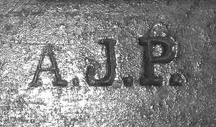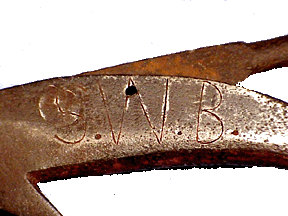 Whalecraft
Whaling
Whalesite
Whalecraft
Whaling
Whalesite


There are different markings that may be found on whalecraft. First there is the blacksmith's mark. This is frequently, but not always, stamped in the iron with a steel stamp while the iron is red hot from the forge. It is usually on the head of a harpoon, lance blade or spade. It may be found on the shaft of a Greener gun iron or other large irons. There was no specific location. I have seen a harpoon from Scotland with the blacksmith's initials I.A. stamped in the socket. The mark may be a name, such as "E.Parker" or initials such as "A.J.P." for Ambrose J. Peters. This mark can help to date an iron and identify its origin (Fairhaven, New Bedford, Nantucket, etc, knowing where the blacksmith worked). Another marking that was stamped similarly into
the head in some cases was "Cast Steel". This indicated a superior blade for lances and spades (never harpoons). It did not mean that the blade was cast in steel, but that it was forged from cast steel stock. Steel held a cutting edge far better than wrought iron. Since steel was introduced in mass production in the 1850's, due to the Bessemer process, it could be economically used. Although known earlier, steel was too costly for use in whalecraft until the Bessemer process.
Another mark that is often found on harpoons, but not other whalecraft, is the ship's
identification, and also whaleboat identification. This was put on harpoons because if a whale was struck and lost, and another ship took that whale they would find the harpoon from the first ship. The ship's identification on the harpoon meant that the whale belonged to it, and not the second ship. This was from an old law that said, "Craft claims the whale." This was explained by Capt. W. H. Macy of Nantucket in his book, "There She Blows! or, The Log of the Arethusa," 1877:
The general rule as established among whalemen is, that "marked craft claims the fish so long as he is in the water, dead or alive." The irons are usually marked with the ship's name, or a convenient abbreviation of it, cut with a small chisel on the flat of the shank, near the head, and if this be found it claims the whale, provided the claimant arrives before the whale is peeled of his blubber. But if another ship has succeeded in cutting him in, no claim can be made. In case the claimant appears during the process of cutting, and a mark is found, he has a right to cut off the blubber square with the plankshear, and take what is blow [sic] it; but can claim nothing that has been raised above it. Such is whaler's law, as settled by established usage; and perhaps nothing could be devised that would be more just than that.
When a harpoon was selected for use, it was cleaned of any preservative paint and rust, and was sharpened. The ship's identification and the identification of the whaleboat in which it was to be used, were crudely cut into the had with a chisel. Sometimes the letters were formed by a series of dots made by a point punch. Usually the ship's identification consisted of initials, such as "E.H.A." for Eunice H. Adams. It could also indicate
the type of whaleship, such as "B.GLA." for Bark Glacier, shown at the left . If a harpoon does not bear these marks, it was not
selected for use and mounted to a pole. It should be noted that the name of the whaleship was stamped into the head or heavy part of the shaft of British harpoons with a stamp similar to the Blacksmith's mark, and was often accompanied by a date. The photo at the right bears the name of whaleship CHIEFTAIN, of Kirkcaldy, Scotland.
The whaleboat identification was also put on a harpoon to keep track of how many whales were taken by any particular boat's crew. If a crew did not take
many whales, there may be some reassignments necessary. It was also for a friendly rivalry. These marks are normally found on the opposite side of the head from the ship's identification. They may be letters, such as "WB" for Waist Boat, Roman numerals (easier to make with a chisel blade), or a series of dots made by a punch point. Whaling ships and barks were known as "four boaters" because they normally carried four whaleboats on the davits. Some Arctic Steamers carried a fifth boat on the Starboard Bow, known as the Starboard Bow Boat.
Normally there was no whaleboat at the starboard waist because that is where the cutting-in stage was located. However, in some rare instances there were Arctic whalers that carried a Starboard Waist Boat. Such a whaler was the Arctic Steamer Karluk. Karluk only took whalebone, not blubber, and it appears that the Starboard Waist Boat stayed in the water to aid in removing the baleen, then was hoisted back onto the cranes after the work was done and the whale cut adrift.

Unusual marking for Starboard Waist Boat. Marking is on a toggle iron from the Steamer Karluk, sailing from San Francisco, circa 1893 - 1897.
From the collection of Robert Hellman, Nantucket.
These boats could be identified as:
Starboard Boat (starboard stern) ____ SB ____I________.
Larboard Boat (larboard stern) _____ LB ____ II_______..
Waist Boat (larboard waist) ________ WB ___ III ______...
Bow Boat (larboard bow)___________ BB ___ IIII or IV __....
Starboard Bow Boat_______________SBB___IIIII or V___.....
Starboard Waist Boat__________ ___SWB_____?________?
The illustration below shows the boat positions on a typical whaleship. The illustration is from Plate 189, Fig. 1, The Fisheries and Fishery Industries of the United States, Section V, History and Methods of the Fisheries by George Brown Goode, Washington, Government Printing Office, 1887.
Smaller whaleships, such as schooners, had only two or three boats: SB, LB and WB, in that order. Some arctic steamers may have carried a fifth boat on the starboard bow, known as the starboard bow boat, and marked SBB or IIIII or V or ..... . The Arctic Steamer Karluk is known to have carried a Starboard Waist Boat, with harpoons marked SWB. There has been some indication that the mate's initials were used on harpoons, but this is not normally the case. That could be difficult to track if boat assignments were changed. The starboard boat was known, through tradition and courtesy, as the Captain's boat; it was headed by the 4th mate. The larboard boat was headed by the 1st mate, the waist boat was headed by the 2nd mate and the bow boat was headed by the 3rd mate.
The name of the whaling port, or blacksmith's city, was not usually stamped on whalecraft. There are some irons that do have a city name, but that is the exception rather than the rule. The mark at the right is L. Cole, (Luther Cole) FAIRHAVEN, on a toggle head Greener iron.
Some gun harpoons that were cast iron have the inventor's name, patent indication and date cast into the shank. This, again, was not always the case. One common gun harpoon with such markings is the Robert Brown gun harpoon at the left, marked "R BROWN PATD 1850." Similar information may also be found on some shoulder guns, darting guns and swivel guns. (See the list of U.S. patents for whalecraft).
There are some rare early examples with an eagle stamped in them. These were apparently made on Nantucket in the first half of the 19th
century. The mark at the right shows an eagle with the initials SBF above it. Samuel Brown Folger was a Nantucket blacksmith making whalecraft as early as 1817. Another similar spade with an eagle is marked NA and attributed to Nathaniel Atwood, a Nantucket blacksmith ca. 1825. (Information and photo courtesy Robert Hellman, Nantucket).
The example above is on a spade in the collection of Robert Hellman, Nantucket.
There were no markings with a crewman's name or date. And there were no markings such as flags or pictures of whales on whalecraft.
Note: All examples on this page are from the author's collection, unless otherwise noted. Back to top of this page
